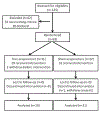Acupuncture for reduction of symptom burden in multiple myeloma patients undergoing autologous hematopoietic stem cell transplantation: a randomized sham-controlled trial
- PMID: 28920142
- PMCID: PMC6159943
- DOI: 10.1007/s00520-017-3881-7
Acupuncture for reduction of symptom burden in multiple myeloma patients undergoing autologous hematopoietic stem cell transplantation: a randomized sham-controlled trial
Abstract
Purpose: Hematopoietic stem cell transplantation (HCT) is potentially curative for a number of hematologic malignancies, but is associated with high symptom burden. We conducted a randomized sham-controlled trial (RCT) to evaluate efficacy and safety of acupuncture as an integrative treatment for managing common symptoms during HCT.
Methods: Adult patients with multiple myeloma undergoing high-dose melphalan followed by autologous HCT (AHCT) were randomized to receive either true or sham acupuncture once daily for 5 days starting the day after chemotherapy. Patients and clinical evaluators, but not acupuncturists, were blinded to group assignment. Symptom burden, the primary outcome was assessed with the MD Anderson Symptom Inventory (MDASI) at baseline, during transplantation, and at 15 and 30 days post transplantation.
Results: Among 60 participants, true acupuncture produced nonsignificant reductions in overall MDASI core symptom scores and symptom interference scores during transplantation (P = .4 and .3, respectively), at 15 days (P = .10 and .3), and at 30 days posttransplantation (P = .2 and .4) relative to sham. However, true acupuncture was significantly more efficacious in reducing nausea, lack of appetite, and drowsiness at 15 days (P = .042, .025, and .010, respectively). Patients receiving sham acupuncture were more likely to increase pain medication use posttransplantation (odds ratio 5.31, P = .017).
Conclusions: Acupuncture was well tolerated with few attributable adverse events. True acupuncture may prevent escalation of symptoms including nausea, lack of appetite, and drowsiness experienced by patients undergoing AHCT, and reduce the use of pain medications. These findings need to be confirmed in a future definitive study.
Trial registration: NCT01811862.
Keywords: Acupuncture; Complementary therapies; Hematopoietic stem cell transplantation; Integrative medicine; Multiple myeloma; Symptom management.
Conflict of interest statement
Figures
Comment in
-
Responses to Comments on Our Previous Publication (Support Care Cancer. 2018 Feb; 26(2):657-665. doi: 10.1007/s00520-017-3881-7.).Support Care Cancer. 2019 Sep;27(9):3173. doi: 10.1007/s00520-019-04898-8. Epub 2019 Jun 18. Support Care Cancer. 2019. PMID: 31209631 No abstract available.
Similar articles
-
Acupuncture for reduction of symptom burden in multiple myeloma patients undergoing autologous hematopoietic stem cell transplantation: a randomized sham-controlled trial. Respond to author.Support Care Cancer. 2019 Sep;27(9):3171-3172. doi: 10.1007/s00520-019-04732-1. Epub 2019 Mar 13. Support Care Cancer. 2019. PMID: 30868268 Clinical Trial. No abstract available.
-
Acupuncture improves certain aspects of sleep in hematopoietic stem cell transplantation patients: a secondary analysis of a randomized controlled trial.Acupunct Med. 2023 Dec;41(6):319-326. doi: 10.1177/09645284231181403. Epub 2023 Jul 6. Acupunct Med. 2023. PMID: 37409464 Free PMC article. Clinical Trial.
-
Reduction of Opioid Use by Acupuncture in Patients Undergoing Hematopoietic Stem Cell Transplantation: Secondary Analysis of a Randomized, Sham-Controlled Trial.Pain Med. 2020 Mar 1;21(3):636-642. doi: 10.1093/pm/pnz190. Pain Med. 2020. PMID: 31498394 Free PMC article. Clinical Trial.
-
Strategies to improve the outcome of stem cell transplantation in multiple myeloma.Hematol J. 2004;5(1):9-23. doi: 10.1038/sj.thj.6200322. Hematol J. 2004. PMID: 14745425 Review.
-
The role of high-dose chemotherapy in the treatment of multiple myeloma: a controversy.Ann Oncol. 2000;11 Suppl 1:55-8. Ann Oncol. 2000. PMID: 10707780 Review.
Cited by
-
Bibliometric Analysis of Acupuncture Therapy for Cancer Pain Over the Past 10 Years.J Pain Res. 2023 Mar 20;16:985-1003. doi: 10.2147/JPR.S395421. eCollection 2023. J Pain Res. 2023. PMID: 36968762 Free PMC article. Review.
-
Acupuncture for reduction of symptom burden in multiple myeloma patients undergoing autologous hematopoietic stem cell transplantation: a randomized sham-controlled trial. Respond to author.Support Care Cancer. 2019 Sep;27(9):3171-3172. doi: 10.1007/s00520-019-04732-1. Epub 2019 Mar 13. Support Care Cancer. 2019. PMID: 30868268 Clinical Trial. No abstract available.
-
Acupuncture in hematologic malignancies and hematopoietic cell transplantation.Blood Rev. 2022 Nov;56:100985. doi: 10.1016/j.blre.2022.100985. Epub 2022 Jun 13. Blood Rev. 2022. PMID: 35725779 Free PMC article. Review.
-
Conceptualizing an Integrative Multiple Myeloma Care: The Role of Nutrition, Supplements, and Complementary Modalities.Nutrients. 2024 Jan 11;16(2):237. doi: 10.3390/nu16020237. Nutrients. 2024. PMID: 38257130 Free PMC article. Review.
-
Benzodiazepine and zolpidem prescriptions during autologous stem cell transplantation.EJHaem. 2021 Feb 6;2(2):276-279. doi: 10.1002/jha2.148. eCollection 2021 May. EJHaem. 2021. PMID: 35845271 Free PMC article.
References
Publication types
MeSH terms
Associated data
Grants and funding
LinkOut - more resources
Full Text Sources
Other Literature Sources
Medical



